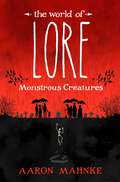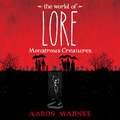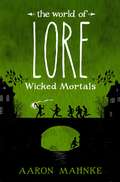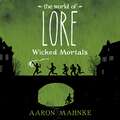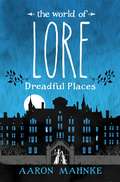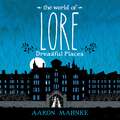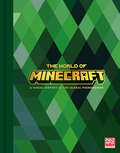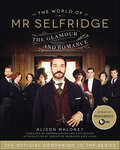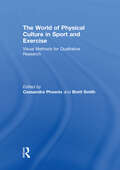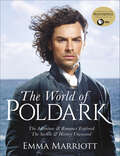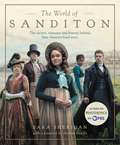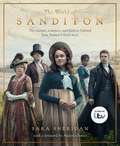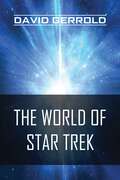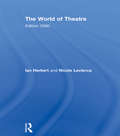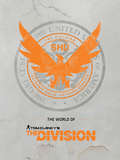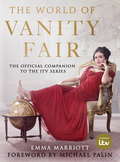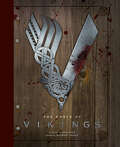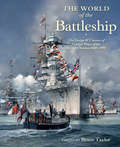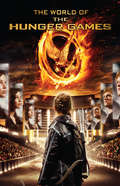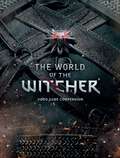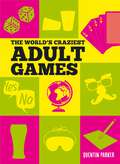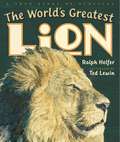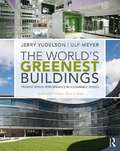- Table View
- List View
The World of Lore, Volume 1: Now a major online streaming series (The World of Lore #1)
by Aaron MahnkeA fascinating, beautifully illustrated collection of stories from the hit podcast Lore - now an online streaming series They live in shadows - deep in the forest, late in the night, in the dark recesses of our mind. They're spoken of in stories and superstitions, relics of an unenlightened age, old wives' tales, passed down through generations. And yet, no matter how wary and jaded we have become, as individuals or as a society, a part of us remains vulnerable to them. Werewolves and wendigos, poltergeists and vampires, angry elves and vengeful spirits.In this beautifully illustrated volume, the host of the hit podcast Lore serves as a guide on a fascinating journey through the history of these terrifying creatures, and explores not only the legends but what they tell us about ourselves. Aaron Mahnke invites us to the desolate Pine Barrens of New Jersey, where the notorious winged, red-eyed Jersey Devil dwells. Mahnke delves into harrowing accounts of cannibalism-some officially documented, others the stuff of speculation . . . perhaps. He visits the dimly lit rooms where séances take place, the European villages where gremlins make mischief, and Key West, Florida, home of a haunted doll named Robert.The monsters of folklore have become not only a part of our language but a part of our collective psyche. Whether these beasts and bogeymen are real or just a reflection of our primal fears, we know, on some level, that not every mystery has been explained, and that the unknown still holds the power to strike fear deep in our hearts and souls. As Aaron Mahnke reminds us, sometimes the truth is even scarier than the lore...Praise for the Lore podcast'Truth can often be much scarier than fiction - something Mahnke proves as he dives deep into the world of folklore and the darker side of history in a quest to root out the fragment of truth at the bottom of our fears." - Entertainment Weekly'Narrated by Mahnke in a style that evokes spooky campfire stories, Lore is a history lesson like no other.' - Esquire
The World of Lore, Volume 1: Now a major online streaming series (The World of Lore #1)
by Aaron MahnkeA fascinating, beautifully illustrated guide to the monsters that are part of our collective psyche, from the host of the hit podcast Lore They live in shadows - deep in the forest, late in the night, in the dark recesses of our mind. They're spoken of in stories and superstitions, relics of an unenlightened age, old wives' tales, passed down through generations. And yet, no matter how wary and jaded we have become, as individuals or as a society, a part of us remains vulnerable to them. Werewolves and wendigos, poltergeists and vampires, angry elves and vengeful spirits.In this beautifully illustrated volume, the host of the hit podcast Lore serves as a guide on a fascinating journey through the history of these terrifying creatures, and explores not only the legends but what they tell us about ourselves. Aaron Mahnke invites us to the desolate Pine Barrens of New Jersey, where the notorious winged, red-eyed Jersey Devil dwells. Mahnke delves into harrowing accounts of cannibalism-some officially documented, others the stuff of speculation . . . perhaps. He visits the dimly lit rooms where séances take place, the European villages where gremlins make mischief, and Key West, Florida, home of a haunted doll named Robert.The monsters of folklore have become not only a part of our language but a part of our collective psyche. Whether these beasts and bogeymen are real or just a reflection of our primal fears, we know, on some level, that not every mystery has been explained, and that the unknown still holds the power to strike fear deep in our hearts and souls. As Aaron Mahnke reminds us, sometimes the truth is even scarier than the lore...Praise for the Lore podcast'Truth can often be much scarier than fiction - something Mahnke proves as he dives deep into the world of folklore and the darker side of history in a quest to root out the fragment of truth at the bottom of our fears." - Entertainment Weekly'Narrated by Mahnke in a style that evokes spooky campfire stories, Lore is a history lesson like no other.' - Esquire(P)2017 Random House Audio
The World of Lore, Volume 2: Now a major online streaming series (The World of Lore #2)
by Aaron MahnkeA chilling, lavishly illustrated who's-who of the most despicable people ever to walk the earth, featuring both rare and best-loved stories from the hit podcast Lore, now an online streaming series. Here are the incredible true stories of some of the mortals who achieved notoriety in history and folklore through horrible means. Monsters of this sort - serial killers, desperate criminals, and socially mobile people with a much darker double-life - are, in fact, quite real . . . including H. H. Holmes, the infamous Chicago serial killer; William Brodie, the Edinburgh criminal mastermind who inspired The Strange Case of Dr. Jekyll and Mr. Hyde; and Bela Kiss, a Hungarian tinsmith with a most disturbing hobby: collecting women in gasoline drums. As Aaron Mahnke reminds us, sometimes the truth is even more frightening than the lore.
The World of Lore, Volume 2: Now a major online streaming series (The World of Lore #2)
by Aaron MahnkeA chilling, lavishly illustrated who's-who of the most despicable people ever to walk the earth, featuring both rare and best-loved stories from the hit podcast Lore, now an online streaming series. Here are the incredible true stories of some of the mortals who achieved notoriety in history and folklore through horrible means. Monsters of this sort - serial killers, desperate criminals, and socially mobile people with a much darker double-life - are, in fact, quite real . . . including H. H. Holmes, the infamous Chicago serial killer; William Brodie, the Edinburgh criminal mastermind who inspired The Strange Case of Dr. Jekyll and Mr. Hyde; and Bela Kiss, a Hungarian tinsmith with a most disturbing hobby: collecting women in gasoline drums.As Aaron Mahnke reminds us, sometimes the truth is even scarier than the lore.(P)2018 Random House Audio
The World of Lore, Volume 3: Now a major online streaming series (The World of Lore #3)
by Aaron MahnkeFor fans of Neil Gaiman and Welcome to Night Vale, Aaron Mahnke's The World of Lore (based on the hit LORE podcast) explores the chilling truth behind the legendary creatures, peculiar people and horrific places that arouse our deepest fears. Now on online streaming seriesVolume 3: Dreadful PlacesThis third book in The World of Lore series will explore dark and dreadful places on land and at sea, places haunted by tragedy and filled with echoes of evil. These are the stories about cities, and buildings, too, from New Orleans to Louisiana and Richmond, Virginia, as well as infamous places like the Stanley Hotel in Colorado and England's most frightening and brooding castles...
The World of Lore, Volume 3: Now a major online streaming series (The World of Lore #3)
by Aaron MahnkeFor fans of Neil Gaiman and Welcome to Night Vale, Aaron Mahnke's The World of Lore (based on the popular LORE podcast) explores the chilling truth behind the legendary creatures, peculiar people and horrific places that arouse our deepest fears. For you see, sometimes the truth is more frightening than fiction...Volume 3: Dreadful PlacesHumans have an uncanny ability to leave their indelible mark. Homes can sometimes reflect the characteristics of their occupants and even cities become more and more like living beings after a century or two. So, it's logical to assume that darker deeds, horrible tragedies, and the worst of human nature all might leave a nefarious taint on some of these places.This third book in The World of Lore series will explore dark and dreadful places on land and at sea, places haunted by tragedy and filled with echo es of evil. These are the stories about cities, and buildings, too, from New Orleans to Louisiana and Richmond, Virginia, as well as infamous places like the Stanley Hotel in Colorado and England's most frightening and brooding castles.(P)2018 Penguin Audio LLC
The World of Minecraft (Minecraft)
by Mojang ABUncover the history of one of the most influential games of all time in The World of Minecraft. Explore how the critically acclaimed game evolved from a one-person project in 2009 to the global gaming phenomenon it is today. The World of Minecraft is the definitive account of the game&’s history, combining exclusive interviews from the Mojang studio and recollections from long-standing members of the gaming community. Read the stories behind mods like Feed The Beast, the growth of community-defining servers like Hypixel, and YouTube channels like The Yogscast, plus a personal account from Lydia Winters on the creation of Alex, the impact of Minecraft charity Block by Block, the origin of the phantom, and many more insights.This must-have collector&’s item includes a foreword from chief creative officer Jens &“Jeb&” Bergensten and an afterword from vanilla Minecraft game director Agnes Larsson, plus original concept art, beautifully detailed renders, and previously unseen archive materials that illustrate how the game has developed over its first fifteen years. Journey back into past eras of the game and look to the future in this comprehensive chronicle of Minecraft&’s story.
The World of Mr. Selfridge: The Glamour and Romance
by Alison MaloneyThe official, full-color, illustrated, behind-the-scenes companion to the lavish hit ITV and PBS television series Mr. Selfridge that vividly brings into focus the remarkable man and his time.Set at the crossroads between the old and the new—when the Victorian and Edwardian eras gave way to the modern age—Mr. Selfridge illuminates the passions, drama, tensions, and promise of the early twentieth century, embodied in one charming, dynamic, self-made man: department store tycoon Harry Gordon Selfridge.Mr. Selfridge follows a colorful cast of characters whose lives and fortunes are entangled with the founder of the magnificent department store that bears his name: Selfridge’s. American retail visionary Harry Selfridge moves to London in 1906 with his family to establish the most ambitious department store the world had ever seen. While his dreams inspire many, they also challenge the staid conventions of British society.A saga bursting with love affairs, class divisions, cultural clashes, ambition, betrayals, and secrets, Mr. Selfridge is set in an era when women reveled in a new sense of freedom and modernity. A charming, dynamic, brilliant, and forceful man who enjoys and respects women, Harry opens the doors of his opulent department story on London's famed Oxford Street to indulge, empower and celebrate them, changing the way the British—and the world—shopped forever.Including a foreword by series producer Andrew Davies, this official illustrated companion to the series—the biggest ITV-produced drama of all time—takes fans on a journey through the world of the series, Selfridge’s, and the larger-than-life entrepreneur, husband, lover, and family man behind it. Rich with historical detail, The World of Mr. Selfridge examines the real man and the fictional character based on him, his relationship with his family, his genius for retail, and his flagship store, including its departments and changing fashions in the early twentieth century.Complete with hundreds of gorgeous photographs, The World of Mr. Selfridge takes a closer look at the cast and their characters over the first two seasons, and looks ahead to series three, which begins in 1919—when Harry’s life really begins to unravel.
The World of Physical Culture in Sport and Exercise: Visual Methods for Qualitative Research
by Cassandra Phoenix and Brett SmithWithin qualitative research in the social sciences, the last decade has witnessed a growing interest in the use of visual methods. Visual Methods in Physical Culture is the first book in the field of sport and exercise sciences dedicated to harnessing the potential of using visual methods within qualitative research. Theoretically insightful, and methodologically innovative, this book represents a landmark addition to the field of studies in sport, exercise, the body, and qualitative methods. It covers a wide range of empirical work, theories, and visual image-based research, including photography, drawing, and video. In so doing, the book deepens our understanding of physical culture. It also responds to key questions, such as what are visual methods, why might they be used, and how might they be applied in the field of sport and exercise sciences.This volume combines clarity of expression with careful scholarship and originality, making it especially appealing to students and scholars within a variety of fields, including sport sociology, sport and exercise psychology, sociology of the body, physical education, gender studies, gerontology, and qualitative inquiry. This book was published as a special issue in Qualitative Research in Sport and Exercise.
The World of Poldark: The Adventure & Romance Explored, The Secrets & History Uncovered
by Emma Marriott“[A] magnificent book . . . A glorious celebration of Graham’s ever-popular novels, the stunning BBC TV adaptation and breathtaking Cornwall.” —Lancashire PostThe World of Poldark explores the characters, the compelling stories and the era that Winston Graham’s Poldark novels—and the television series—set out to recreate, the England that Ross Poldark returned to from the American War of Independence. England, and especially Cornwall, was then marked by social unrest and a deep division between rich and poor. It was a place of tin mines and shipwrecks, of new money versus old, of harsh justice and great kindness.Amid the turmoil of eighteenth-century Cornwall, Ross comes back to a home in ruins, his father dead and his childhood sweetheart engaged to another—his own heart as battered as the country around him.Experience the great houses and the glorious landscapes and follow the cast of characters as their stories play out against the backdrop of Cornwall’s wild beauty, through interviews with the actors, behind the scenes insights and in-depth information on costumes, props and locations. Packed full of behind the scenes photographs, The World of Poldark is the ultimate guide to the popular series.“If you’re interested in the show and missed the first season, or a fan of the books or possibly just think Aidan Turner is super hot, this a good book for you.” —The Parkersburg News and Sentinel“Beautifully produced . . . a downright pleasant surprise, a detailed and engaging look at book, show, and history where it could easily have gotten away with merely being a detailed look at fuzzy pectorals.” —Open Letters Monthly
The World of Sanditon: The Official Companion To The Itv Series
by Andrew Davies Sara Sheridanp.p1 {margin: 0.0px 0.0px 0.0px 0.0px; line-height: 14.0px; font: 12.0px Times; color: #000000; -webkit-text-stroke: #000000} span.s1 {font-kerning: none} An exclusive behind-the-scenes look at the making of Jane Austen's Sanditon television series. Sanditon, the final novel Austen was working on before her death, has been given an exciting conclusion, and will be brought to a primetime television audience on PBS/Masterpiece for the very first time by Emmy and BAFTA Award winning screenwriter Andrew Davies (War & Peace, Mr. Selfridge, Les Misérables, Pride and Prejudice). This, the official companion to the Masterpiece series, contains everything a fan could want to know. It explores the world Austen created, along with fascinating insights about the period and the real-life heartbreak behind her final story. And it offers location guides, behind the scenes details, and interviews with the cast, alongside beautiful illustrations and set photography.
The World of Sanditon: The Official Companion to the ITV Series
by Sara SheridanThe official TV tie-in to accompany the ITV drama scripted by Andrew DaviesThe World of Sanditon delves behind the scenes of Sanditon, giving you the inside scoop on Jane Austen's unfinished masterpiece, adapted for television by Andrew Davies.Produced by Red Planet Pictures, ITV's Sanditon series tells the story of the joyously impulsive, spirited and unconventional Charlotte Heywood and her spiky relationship with the humorous, charming and slightly wild Sidney Parker. Written by Emmy and BAFTA-Award winning writer Andrew Davies, the series brought Austen's story to life and this book will allow you to go behind the scenes of the cast and crew, exploring the world that Austen created and offering fascinating insights about the period and about the real-life heartbreak behind her final story. Readers will also have access to location guides, interviews with the cast, and in-depth historical information by esteemed author Sara Sheridan.
The World of Star Trek: The Inside Story Of Tv's Most Popular Series
by David GerroldIn The World of Star Trek, David Gerrold opens up dialogue on the people, places, and events that made Star Trek one of the most popular series ever. Gerrold discusses what was successful and what wasn't, offering personal interviews with the series' legendary stars and dissecting the trends that developed throughout the seasons. The complete inside story of what happened behind the scenes of the Star Trek universe, from scriptwriters' memos to special effects and more, The World of Star Trek is the companion all Trekkies need for the most all-encompassing breakdown and analysis of Star Trek.
The World of Theatre: Edition 2000
by Ian Herbert Nicole LeclercqThe World of Theatre is an on-the-spot account of current theatre activity across six continents. The year 2000 edition covers the three seasons from 1996-97 to 1998-99, in over sixty countries - more than ever before. The content of the book is as varied as the theatre scene it describes, from magisterial round-ups by leading critics in Europe (Peter Hepple of The Stage) and North America (Jim O'Quinn of American Theatre) to what are sometimes literally war-torn countries such as Iran or Sierra Leone.
The World of Tom Clancy's The Division
by UbisoftIncisive lore and detailed art in a cunningly designed hardcover that will bring readers into the ravaged streets of New York City and Washington DC as seen in Ubisoft's record-breaking videogame series!On Black Friday, a deadly biological attack was thrust upon the populace of New York. Within weeks, millions lay dead, and the city was placed under quarantine. The only force with any hope of restoring order are the embedded agents of the SHD--more commonly known as the Division. Despite the quarantine, the infection continues to spread across the country. Amidst a ruined government, a shattered infrastructure, and an eroding civilization, the Division is now called to action in Washington DC--but if the agents fail, the capital will fall, and the nation with it.The World of Tom Clancy's The Division is the meticulously crafted result of a partnership between Dark Horse books and Ubisoft Entertainment, offering readers a unique insight into the chaotic and dangerous world of the hit games. Don't miss this opportunity to learn all there is to know about the tactical methods, the high-tech tools, and the all-important mission of the Division!
The World of Vanity Fair
by Emma MarriottTHE OFFICIAL COMPANION TO THE ITV SERIESWilliam Thackeray's Vanity Fair was first published in the 1840s, but its power to entertain and provoke debate remains as strong as ever. The tales of charismatic, shrewd, and amoral Becky Sharp's journey from Miss Pinkerton's academy for young ladies to a wider world in which wealth and status is valued above all else is arguably as relevant today as it was nearly 200 years ago: Becky and her equally flawed friends and acquaintances are familiar to us all.This, the official companion to the ITV series contains everything a fan could want to know about the story. It explores the characters Thackeray so memorably created and the society they inhabited, along with fascinating insights about the period. And it offers location guides, behind the scenes details, and interviews with the cast, alongside beautiful illustrations and set photography.Taking readers from London society to the battlefields of Waterloo, the book gets right to the heart of one of the greatest novels ever written.
The World of Vanity Fair
by Michael Palin Emma MarriottTHE OFFICIAL COMPANION TO THE ITV SERIESWilliam Thackeray's Vanity Fair was first published in the 1840s, but its power to entertain and provoke debate remains as strong as ever. The tales of charismatic, shrewd, and amoral Becky Sharp's journey from Miss Pinkerton's academy for young ladies to a wider world in which wealth and status is valued above all else is arguably as relevant today as it was nearly 200 years ago: Becky and her equally flawed friends and acquaintances are familiar to us all.This, the official companion to the ITV series contains everything a fan could want to know about the story. It explores the characters Thackeray so memorably created and the society they inhabited, along with fascinating insights about the period. And it offers location guides, behind the scenes details, and interviews with the cast, alongside beautiful illustrations and set photography.Taking readers from London society to the battlefields of Waterloo, the book gets right to the heart of one of the greatest novels ever written.
The World of Vikings
by Justin PollardThe official companion book to the first three seasons of the hit History Channel show inspired by a legendary Viking warrior.MGM’s hit show Vikings on the History Channel has drawn millions of viewers into the fascinating and bloody world of legendary Norse hero Ragnar Lothbrok, who led Viking warriors to the British Isles and France. Covering the first three seasons of the series, this official companion book delves into the real history as well as the behind-the-scenes stories. Viking historian Justin Pollard explains shipbuilding and navigation, Norse culture and religion, and the first encounters between Viking warriors and the kings of England and France. Interviews with cast and crew reveal the process of dramatizing this gripping story, from reviving the Old Norse language to choreographing battle scenes and building ancient temples for human sacrifice. This ebook is a must for fans of the show and history buffs alike.VIKINGS © 2015 TM Prods Ltd/T5 Vikings Prods Inc. VIKINGS™ TM Prods Ltd.Praise for The World of Vikings“A gorgeous companion book to the hit series . . . The World of Vikings is an excellent piece for the avid Vikings fan. I highly recommend it.” —Geeks of Doom“This is a whole new way of learning about Vikings. This book is full of the legends and the lifestyle, with pictures to boot. It is a great read for any proud Scandinavian.” —Grand Forks Herald
The World of the Battleship: The Design & Careers of Capital Ships of the World's Navies, 1880–1990
by Bruce TaylorThis new volume is intended to present a global vision of the development of the world's battleships. In a collection of chapters by international, the design, building, and career of a significant battleship from each of the world's navies is explored that illuminates not just the ships but also the communities of officers and individuals that served in them and, more broadly, the societies and nations that built them. Each chapter explains the origins of a ship, her importance as a national symbol, and her place in the fleet. This is a highly original and significant book on the great capital ships of the world.
The World of the Hunger Games (The\hunger Games Ser.)
by Kate EganThe definitive, richly illustrated, full-color guide to all the districts of Panem, all the participants in the Hunger Games, and the life and home of Katniss Everdeen.Welcome to Panem, the world of the Hunger Games. This is the definitive, richly illustrated, full-color guide to all the districts of Panem, all the participants in The Hunger Games, and the life and home of Katniss Everdeen. A must-have for fans of both The Hunger Games novels and the new Hunger Games film.
The World of the Witcher: Video Game Compendium
by CD Projekt RedDive deep into the world of monster hunters, as the prominent characters from the universe take you on a guided tour of the fascinating dark fantasy adventure that is The Witcher. This gorgeous, illustrated hardbound volume contains in-depth knowledge about the locales, the deadly beasts that inhabit them, and the lethal weapons used to put them down.
The World's Craziest Adult Games
by Quentin ParkerDo you want to jazz up your dinner parties or get-togethers? Are you looking for exciting new games to play at your wild house parties? With old classics like Spoons and the Cereal Box Game, alongside new gems waiting to be discovered such as Mafia and Slip It In, this is the only book you need to become a legendary party host.
The World's Craziest Adult Games
by Quentin ParkerDo you want to jazz up your dinner parties or get-togethers? Are you looking for exciting new games to play at your wild house parties? With old classics like Spoons and the Cereal Box Game, alongside new gems waiting to be discovered such as Mafia and Slip It In, this is the only book you need to become a legendary party host.
The World's Greatest Lion
by Ralph HelferFrom the creators of The World's Greatest Elephant comes the real-life story of the MGM Studios Lion. Perhaps the most recognizable Hollywood animal--outside of Lassie--is "Leo the Lion," MGM Studios' famous mascot. For decades his image introduced hundreds of motion pictures, and Zamba the lion acted in dozens more. But he wasn't always a Hollywood star, and he certainly proved to be much more. This real-life story of Zamba, told by world-renowned animal behaviorist Ralph Helfer and Caldecott Honor recipient Ted Lewin, follows the famous lion from an orphaned cub in Africa to iconic Hollywood actor. But Zamba's greatest role wasn't scripted and it certainly wasn't captured on film. In 1969, the canyon that housed Ralph Helfer's animal ranch was ravaged by floods. As death claimed many of the animals, dozens were led to safety by one heroic lion. Zamba's story, beautifully told and illustrated, is one that will entertain and inspire--both cubs and lions.
The World's Greenest Buildings: Promise Versus Performance in Sustainable Design
by Jerry Yudelson Ulf MeyerThe World’s Greenest Buildings tackles an audacious task. Among the thousands of green buildings out there, which are the best, and how do we know? Authors Jerry Yudelson and Ulf Meyer examined hundreds of the highest-rated large green buildings from around the world and asked their owners to supply one simple thing: actual performance data, to demonstrate their claims to sustainable operations. This pivotal book presents: an overview of the rating systems and shows "best in class" building performance in North America, Europe, the Middle East, India, China, Australia and the Asia-Pacific region practical examples of best practices for greening both new and existing buildings a practical reference for how green buildings actually perform at the highest level, one that takes you step-by-step through many different design solutions a wealth of exemplary case studies of successful green building projects using actual performance data from which to learn interviews with architects, engineers, building owners and developers and industry experts, to provide added insight into the greening process This guide uncovers some of the pitfalls that lie ahead for sustainable design, and points the way toward much faster progress in the decade ahead.
